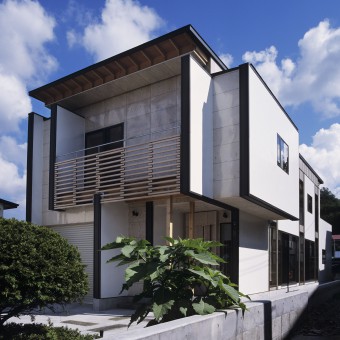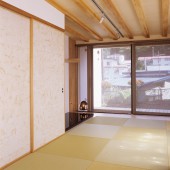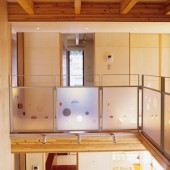Space in Layers Private Residence by ir Frank la Rivière |
Home > Winners > #61060 |
 |
|
||||
| DESIGN DETAILS | |||||
| DESIGN NAME: Space in Layers PRIMARY FUNCTION: Private Residence INSPIRATION: The kind of varying depth as in old Dutch paintings in which there are always a series of adjacent spaces visible that extend beyond the limits of the space was a source of inspiration. These in-between zones both separate and connect the main spaces, like cross passages in the city. They are part of the circulation giving access to the functions in the service zone, such as the staircase to the second floor, the bathroom, storage and toilets in a free flow of space. UNIQUE PROPERTIES / PROJECT DESCRIPTION: Constructed on a deep plot of land in Aomori prefecture, this low budget residence would automatically be long stretched. Exploring a sense of openness and transparency by making the depth of the space measurable through the introduction of in-between zones, results is a layering of space. A spatial quality that allows looking through several spaces, gives a feel of openness. From the entrance, one can see through the living room, dining area and the Japanese room into the garden in the back. OPERATION / FLOW / INTERACTION: All these major spaces are determined by the in-between zones that create the same kind of varying depth as in a old Dutch paintings in which there are always a series of adjacent spaces visible that extend the limits of the space. . The result is a layering of space. Looking through several spaces, whether interior or exterior, gives a feel of openness. PROJECT DURATION AND LOCATION: Design period: March 2002- august 2006 Construction period: August, 22 2006 – December, 29 2006 (landscaping until end of April 2007) Final delivery January 2008. FITS BEST INTO CATEGORY: Architecture, Building and Structure Design |
PRODUCTION / REALIZATION TECHNOLOGY: The main structure is a wooden column and post structure left exposed in the ceilings of the main spaces. Only a few finishing materials are used and in a clear order. The walls in the length of the house are finished with 900 x 900 mm square rawan plywood panels treated with transparent lacquer while in contrast in the cross direction the walls are finished in Japanese spruce plywood. The floors are in birch plywood for the main spaces and orange brown plywood (Nitax Wisa Light Brown from Finland that is protected with a poly-vinyl layer developed as material for concrete form work) for the in-between zones. The Japanese room and the master bed room is finished with a tatami floor while the spare bedroom has a floor of Larch plywood stained whitish the same as the ceilings of the main spaces. Only the in-between zones have a lowered ceiling that accentuates the meaning of these zones. Being in an area of Japan with cold winters with a lot of snow in addition to this passive heat gain on the south side glazing, the house was isolated with 100 mm insulation material and all the windows were fitted with pair glass. SPECIFICATIONS / TECHNICAL PROPERTIES: Site: 349.67 m2 Total surface: 194 m2 L1: 114.58 m2 L2: 79.55 m2 Allowable square meters: 200% Foot print: 60% Levels: 2 above grade Maximum height: 6.825 m TAGS: Aomori, Tsugaru, snow, insulation, zoning, architecture, interior RESEARCH ABSTRACT: One of the issues posed by the long stretched site was how to come to a space design that was not just a long box like space. The design research was greatly centred on solving this peculiarity of the commission. A space reference was found in old Dutch paintings that have a kind of varying depth, in which there are always a series of adjacent spaces visible that extend the limits of the space. This notion of space experienced over several limits led to the introduction of the intermediate zones that separate the main spaces, hence creating a rhythm that makes the depth of the plot measurable. CHALLENGE: A major challenge of this project was to direct a construction site in a remote province while being based in Tokyo. The modularity of the house was both a very effective strategy to communicate precise positioning of elements with the construction company as well as an important determinant for the proportioning of the spaces. We were fortunate to work with a good contractor with a great understanding of constructing in the area and who was very supportive of the design. ADDED DATE: 2017-09-25 09:27:39 TEAM MEMBERS (2) : Architect: ir Frank la Rivière and Structural Design: Sato Jun, Structural Engineer IMAGE CREDITS: ir Frank la Rivière, FRA inc PATENTS/COPYRIGHTS: Copyrights belong to ir Frank la Rivière, 2008 |
||||
| Visit the following page to learn more: http://www.frank-la-riviere.com/ | |||||
| AWARD DETAILS | |
 |
Space in Layers Private Residence by Ir Frank La Rivière is Winner in Architecture, Building and Structure Design Category, 2017 - 2018.· Press Members: Login or Register to request an exclusive interview with ir Frank la Rivière. · Click here to register inorder to view the profile and other works by ir Frank la Rivière. |
| SOCIAL |
| + Add to Likes / Favorites | Send to My Email | Comment | Testimonials | View Press-Release | Press Kit |







